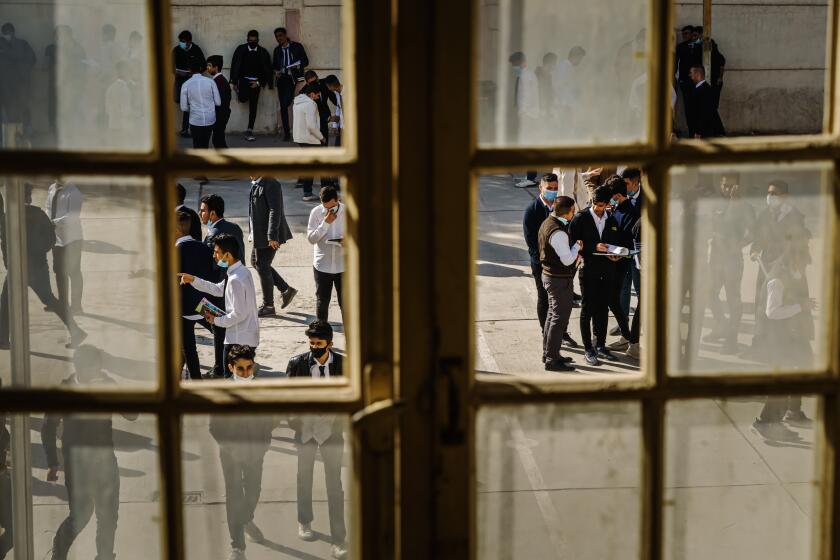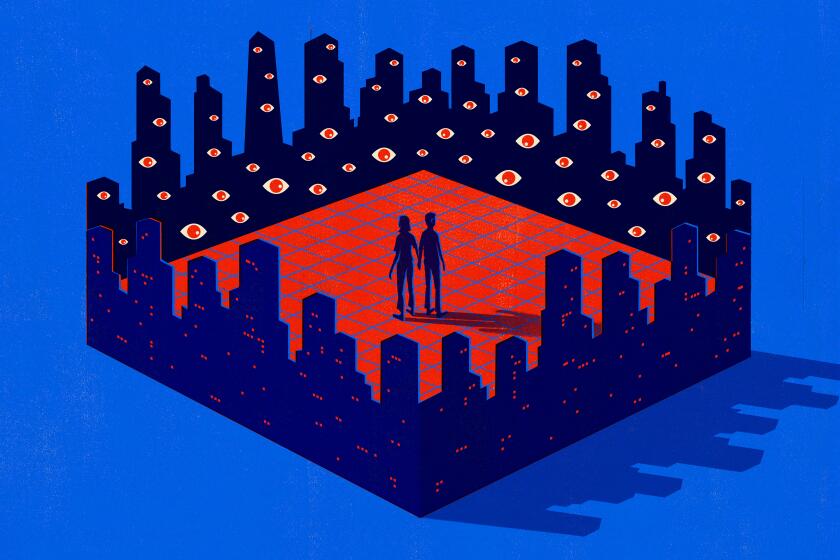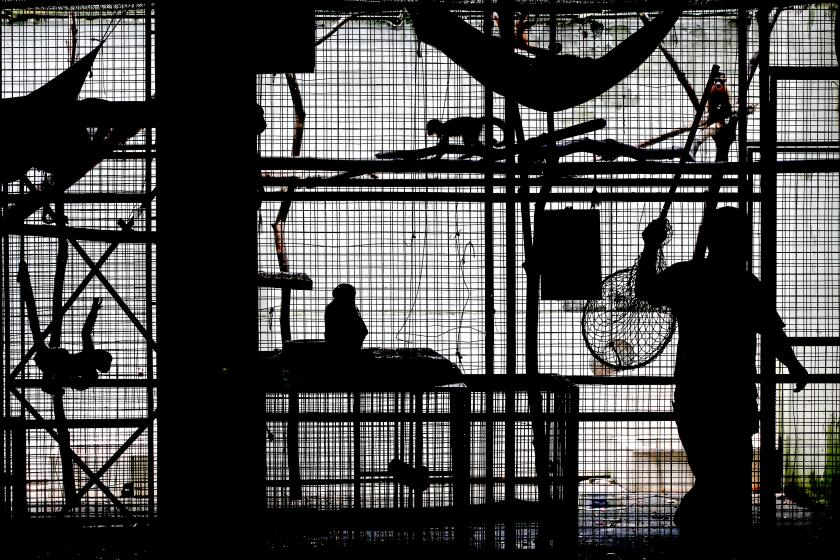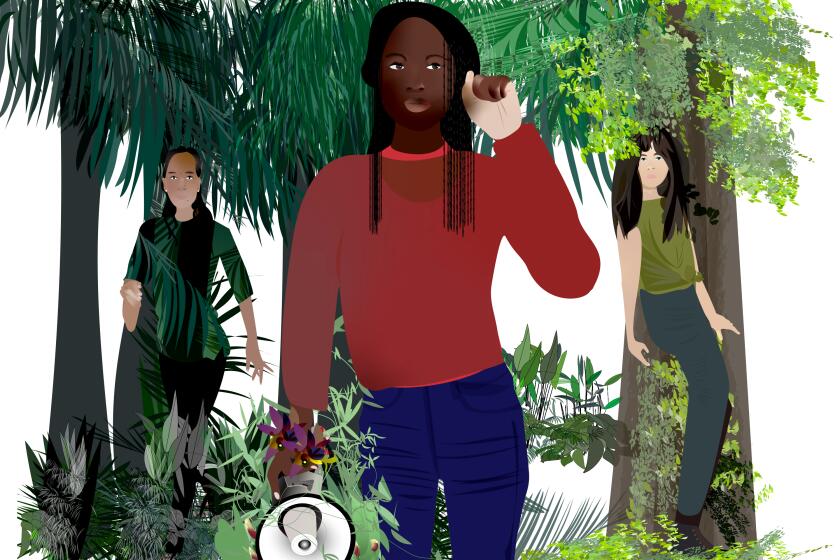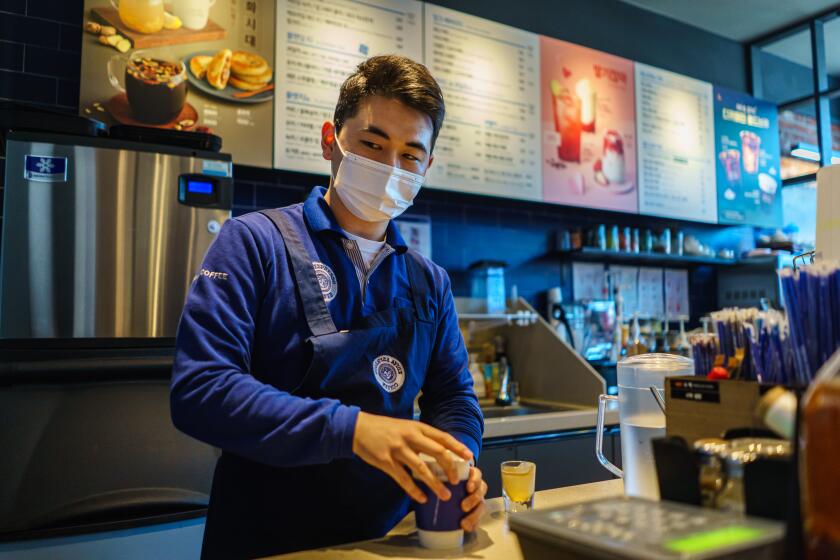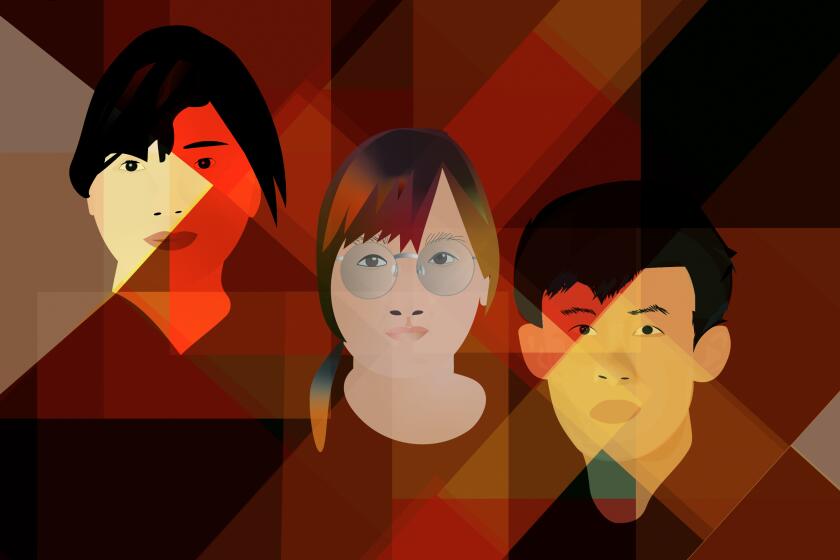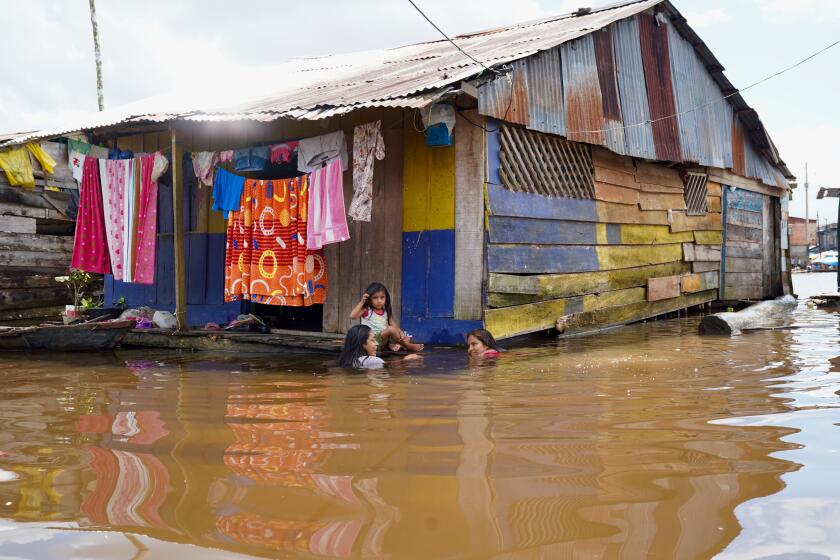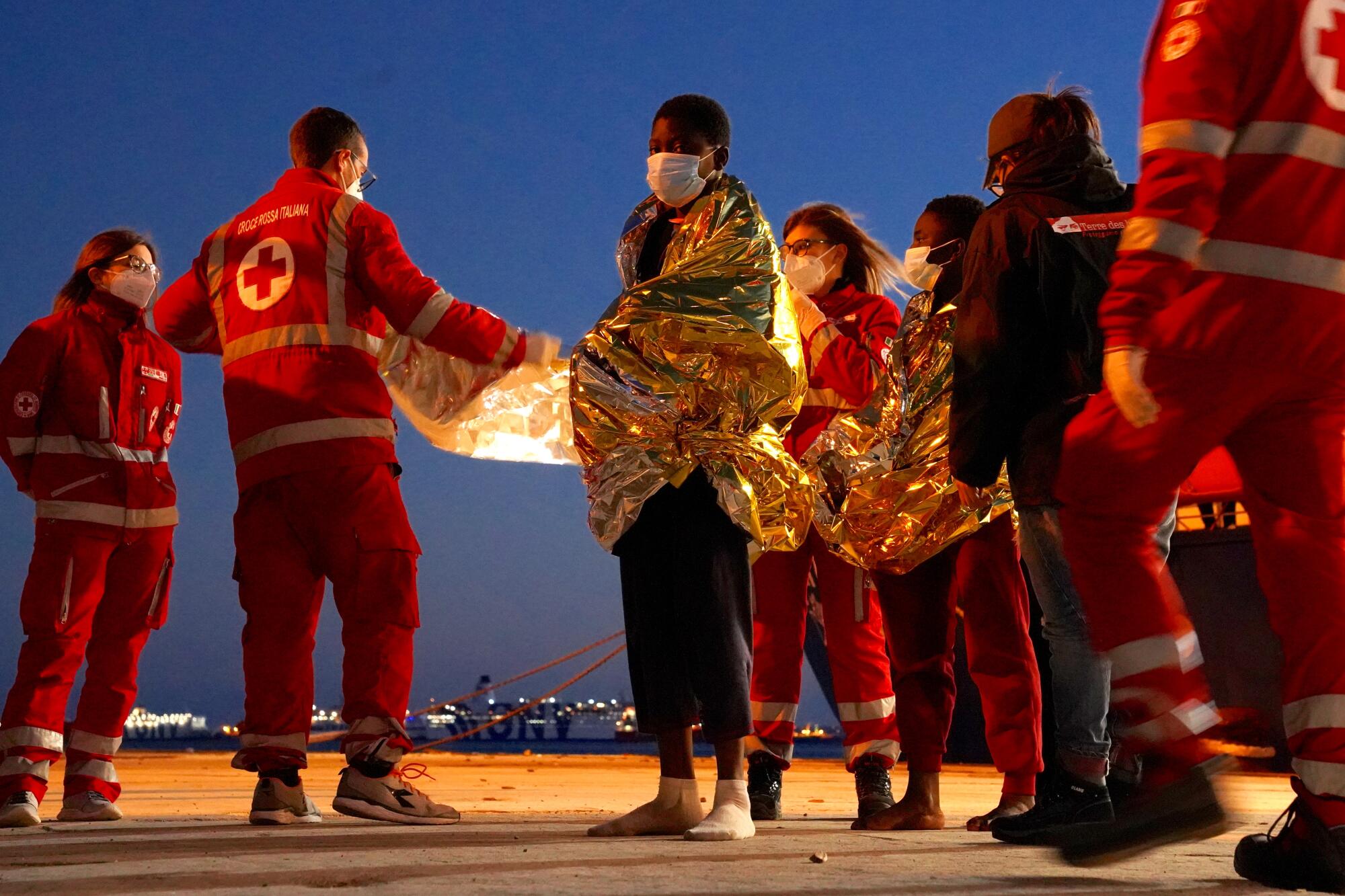
- Share via
AUGUSTA, Italy — The rescue ship pulled into port ferrying its doleful load — hundreds of men, women and children, mostly from sub-Saharan Africa and the Middle East. All had been plucked from ragged vessels adrift in the Mediterranean, where this year more than 1,600 migrants and refugees have been lost at sea.
They had finally reached the continent that had consumed their dreams. But Europe was not welcoming. Hollowed-out stares from the decks fixed on police cars, flashing lights and ambulances on the quay. The migrants shivered in gray blankets as the sun set on the Sicilian coast against a backdrop of moored sea liners and the rusting detritus of forgotten freight.
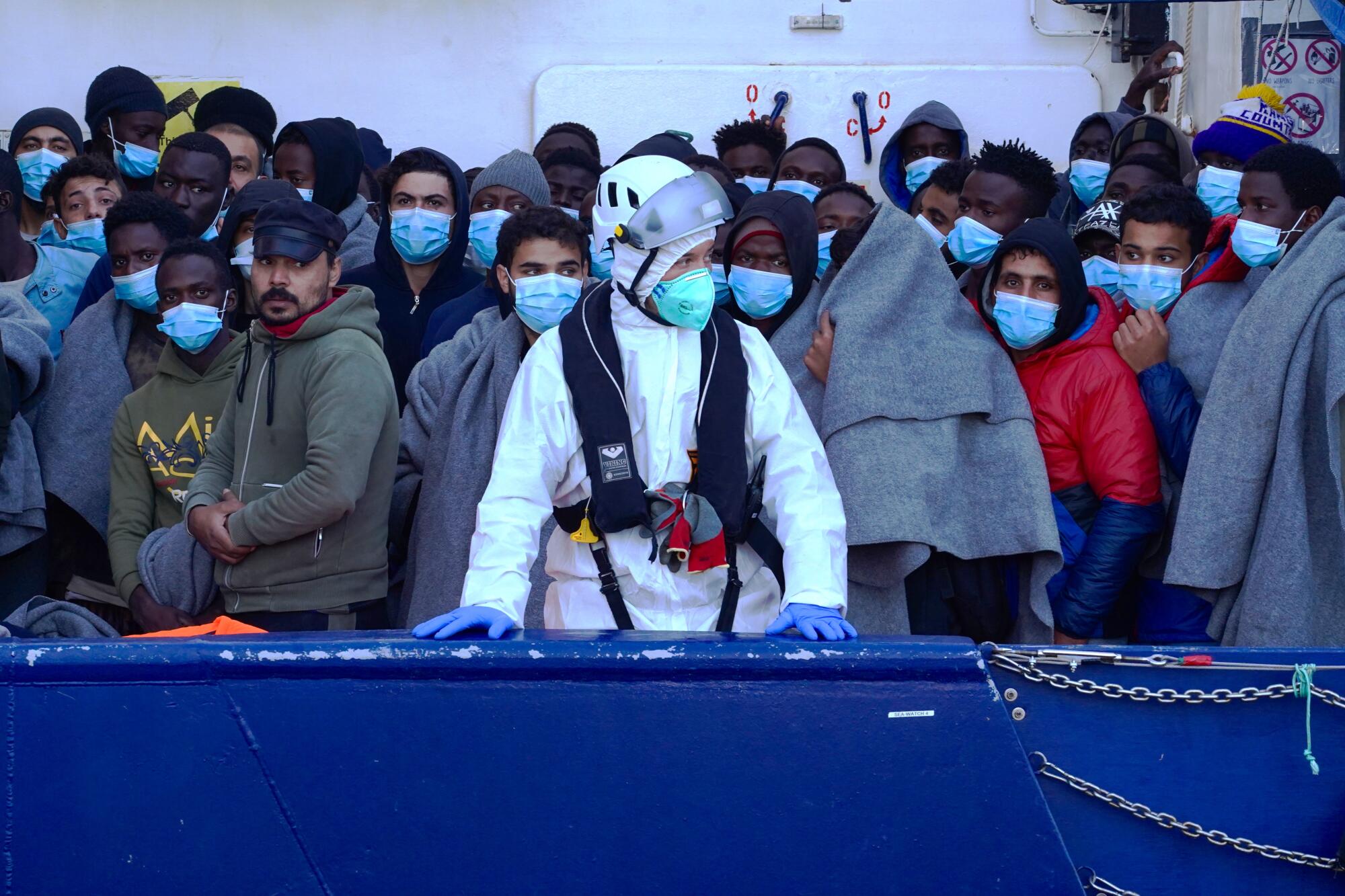
Many aboard were young people who had embarked on epic odysseys, escaping war zones, poverty and — perhaps most of all — a suffocating dearth of hope and opportunity at home. They had endured a gamut of smugglers, thieves and militiamen who eye them as booty to be bartered for ransom, slave labor, or as cannon fodder for the next holy war.
The World They Inherit
This is the ninth in a series of occasional stories about the challenges young people face in an increasingly perilous world. Reporting was supported by a grant from the Pulitzer Center.
“I was one of these kids,” said Sano Sankoung, 25, a native of Senegal in West Africa who was among the aid workers helping the newcomers in the Sicilian port of Augusta. It was Sankoung’s first trip back to the docks since a ship dropped him off here almost a decade ago after he was saved from an overloaded rubber raft.
“This was God’s work,” Sankoung said as the youths, including 141 unaccompanied children, stepped off the Sea-Watch 4’s gangplank. “God — and some luck.”
::
This year saw surging numbers of migrants crashing borders. COVID-19 lockdowns eased against a backdrop of worsening “push factors” — including armed conflict, climate change and a global wealth gap that widened as pandemic-triggered recessions exacerbated inequality. The Ethiopian civil war, the Taliban takeover of Afghanistan, the Haitian influx from South America, the political weaponization of migrants along the Belarusian-Polish border — all highlighted the desperation driving people from their homelands.
The young are at the forefront. They are converging on the U.S. border and on multiple entry points to Europe, from the English Channel to the Mediterranean to the continent’s eastern flanks. Many hail from regions with predominantly youthful populations, median ages typically in the low 20s, well below those in Western Europe and the United States.
A record of almost 150,000 unaccompanied minors, more than 75% from Central America, were detained along the U.S.-Mexico border in fiscal 2021, according to U.S. Customs and Border Protection. Many more teens and young adults arrived during a period that set an all-time high for overall border apprehensions — nearly 1.7 million.
Europe saw at least 160,000 irregular crossings by migrants and refugees arriving via sea and land during January-October 2021, a 70% jump from the same period in 2020, according to Frontex, the European border control agency. Almost 80% of more than 5.5 million first-time asylum seekers in Europe since 2014 were 34 or younger, according to Eurostat, the statistical branch of the European Union. Close to one-third were under 18.
Their arrivals have met a populist backlash fired up by politicians such as former President Trump and Hungarian Prime Minister Viktor Orban. But the young keep coming, transcending distance and danger in search of better lives in the world they are inheriting.
“In many parts of the world, people have to make choices at the age of 15, 16, 17 about the rest of their lives,” said Andrew Seele, president of the Migration Policy Institute, a Washington-based research institution. “It’s the age of migration in many societies, whether someone is looking to enter the work force, escape civil wars, or running from being recruited into criminal enterprises.”
::
Marisa Joseph is an animated 18-year-old camped with multitudes of tent-dwellers on a beach along a stretch of Caribbean in northwest Colombia.
“I’m not scared,” Joseph declares, sitting on a palm log in the coastal town of Necoclí, cradling her 1-year-old son, who has a slight fever — and is in no shape for the slog ahead through the dense forest. “I’m determined to go forward, despite everything.”
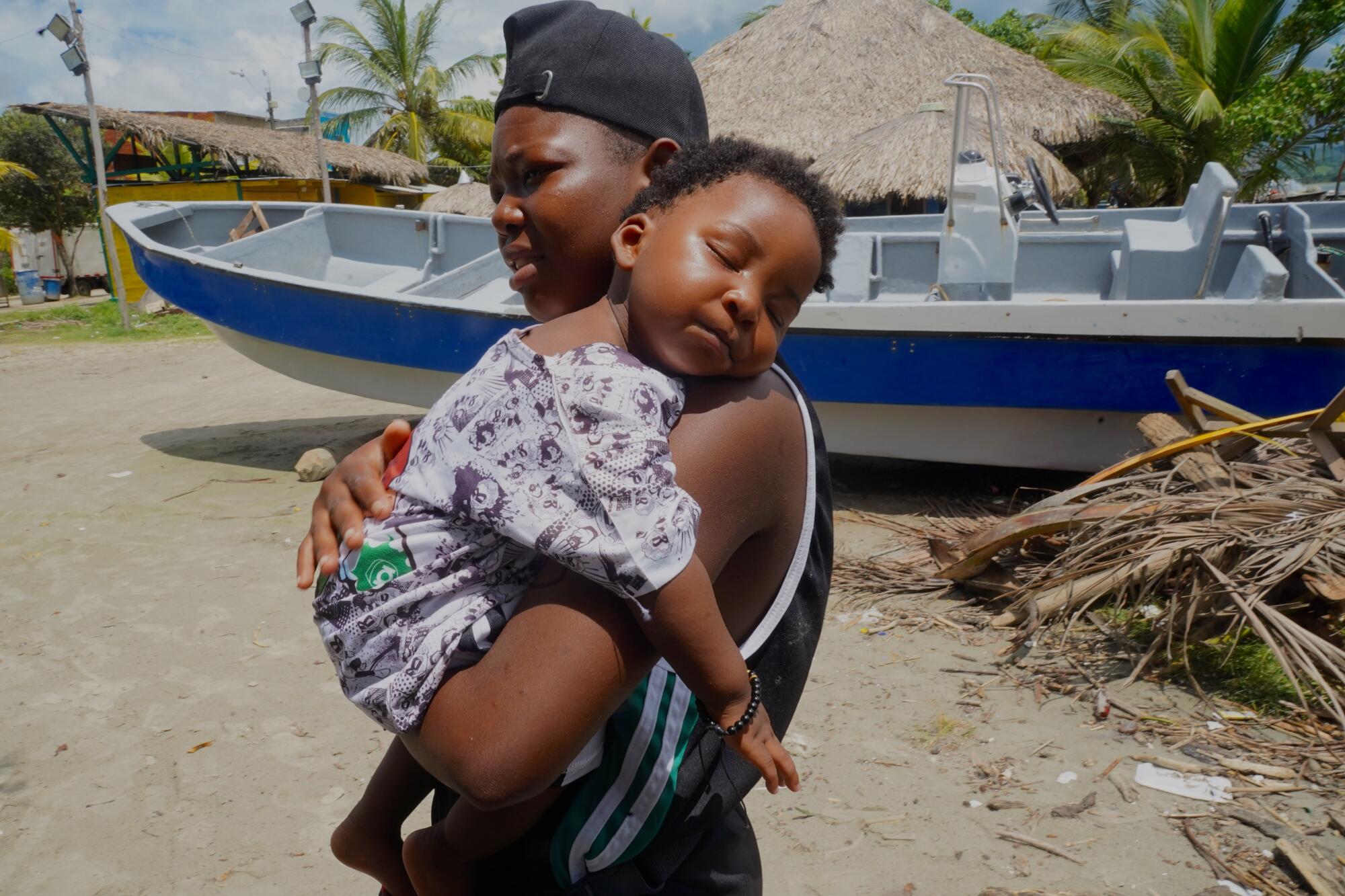
She, her husband, Wiggins Pierre, 21, and their son, Wiggins Iván, are part of the extraordinary rise in U.S.-bound migrants from Haiti who have been departing South America, sometimes traveling 4,000 miles in an intercontinental trek. They have been driven north by pandemic-battered economies and a crackdown on foreigners.
“We are here out of necessity,” explains Joseph, who hopes to reach relatives in New York and Miami, hubs of the diaspora from Haiti, long among the hemisphere’s poorest nations and most dependent on remittances from abroad. Haitians compose about 75% of the unprecedented 121,000-plus foreigners who have entered Panama so far in 2021 after treacherous hikes through the Darien Gap, the strip of rainforest between Colombia and Panama.
The migrants wait, sometimes for weeks, to catch boats from Necoclí across the Gulf of Urabá and continue their northward trip to the Darien. Joseph and her family shelter in a tent bought from a street-side vendor. It provides scarce protection from the blazing afternoon sun and daily tropical downpours.
She flashes a broad smile and says she would like to go to university in the United States, perhaps to study acting: “I took a course in Chile,” she says, “but I never made it on television or anything like that.”
Joseph and her husband, who wants to enlist in the U.S. military, met in Chile, which took in tens of thousands of Haitians following the Caribbean nation’s catastrophic 2010 earthquake. She worked in a clothing store, her husband in a furniture factory. The couple saw no future in Chile, where they earned the minimum wage of about $400 a month.
“I want my son to have a good education,” said Joseph. “That’s why we are here, risking everything.”
She bides her time on the beach as boats of migrants embark across the gulf and new arrivals seek out vacant plots in this tent city on the crowded strand, where promise and frustration push against the Caribbean tide.
::
Half a world away, Ali Abbass, 21, is a struggling barber in Baghdad.
He had heard in September that there were easy visas to Belarus, the former Soviet republic that borders the European Union nations of Poland, Lithuania and Latvia. Abbass, who is single and saw little chance to improve his circumstances in Iraq, mapped out a route and borrowed $2,500 for a trip that would take him through Iran to Turkey and onto the Belarusian city of Brest, near the Polish border.
Things went bad quickly after he landed in Belarus. President Alexander Lukashenko was funneling Abbass and thousands of other migrants and refugees toward EU countries in retribution for sanctions against his repressive rule. Before Abbass could even attempt to cross into Poland, Belarusian soldiers grabbed him and took his passport and phone. They detained him for four days, then ferried him away from Brest and dumped him as part of a group near the border with Lithuania.
“There was so much harassment,” he said. “The Belarusian army really hurt us.”
After nine hours of trying to get through the no-man’s land into Lithuanian territory, Abbass gave up.
“I couldn’t make it across. The army was deployed all over,” he said. He turned back toward the Belarusian side, joining thousands of others in a makeshift refugee camp. He was trapped at the edge of a Europe that did not want him. There was no food or drink, and temperatures regularly plunged below freezing. Every time he and others tried to leave for the Belarusian capital of Minsk, soldiers beat them back.
“We ended up drinking from a swamp nearby,” said Abbass, who had survived nearly two decades of war and unrest in Iraq only to find himself facing new dangers. “The whole experience from beginning to end was just suffering.”
He waited a few days and attempted again to enter Lithuania. When he failed, he decided he had enough. He paid what little money he had left for a smuggler to return him to the capital. He had been defeated. When word came that the Iraqi government was offering repatriation flights home, Abbass signed on.
He’s back at the barber shop in Baghdad. His future looks no better — perhaps it’s even worse. He doesn’t know how he’ll pay back the loan he took for his ill-fated trip.
“I knew it was a risk,” he said, “but I didn’t expect it to get to the point of death.”
::
In Italy, they are sometimes called gli invisibili — the invisible ones, though in truth they are quite apparent.
Young African men can be seen putting up Christmas decorations on posh storefronts in Milan, peddling trinkets outside the Colosseum in Rome, hawking jackets, shoes and knock-off designer bags along the promenade at the Bay of Naples. They pick crops in the fields and provide day labor at construction sites, while women work as nannies and housekeepers.
Many — like those who arrived on the Sea-Watch 4 rescue boat — lack legal status to claim asylum or other forms of relief. They languish.
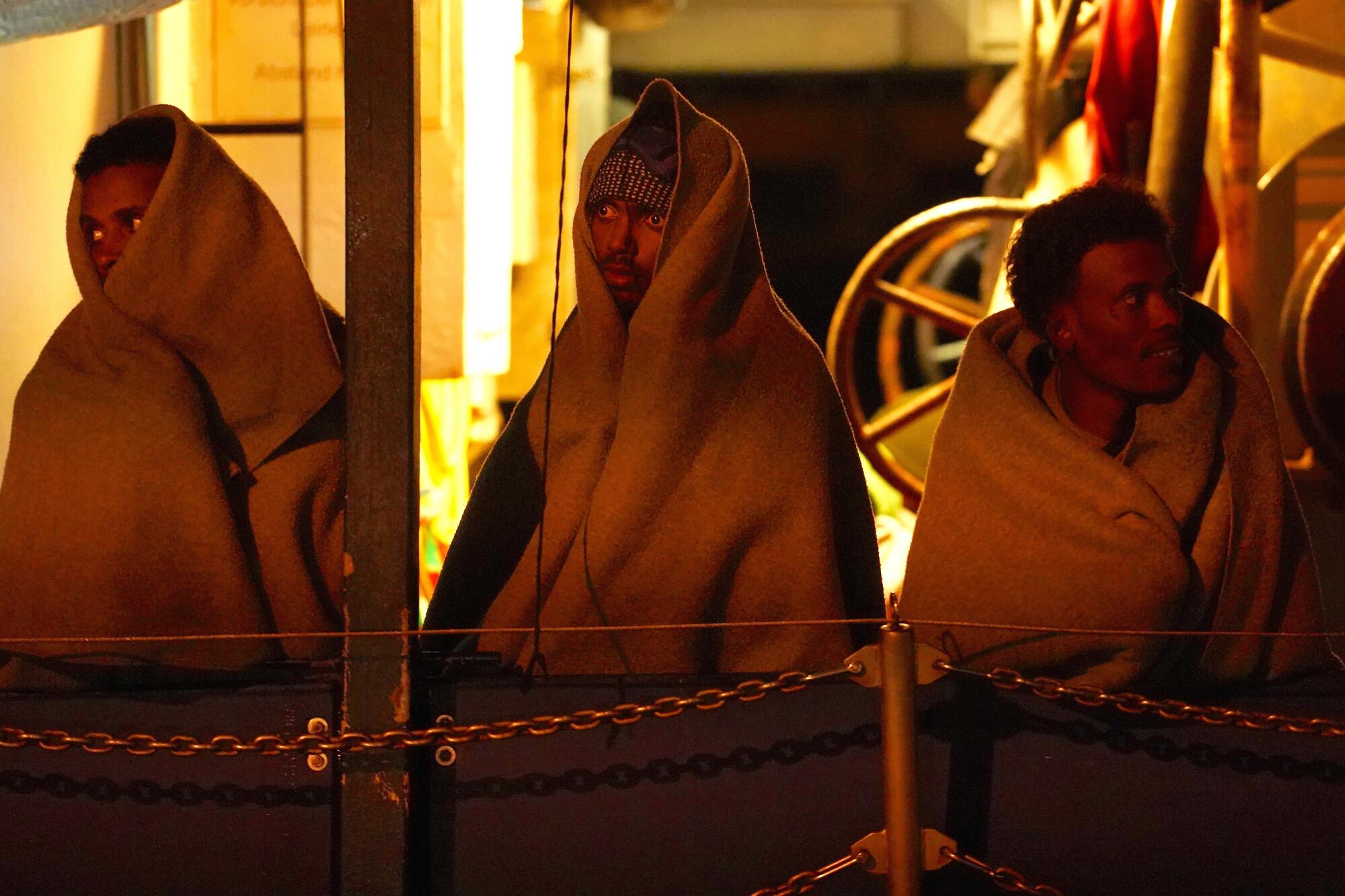
“It’s very hard to find any work here without papers,” said Yeboah Kwaku Haruna, 21, a Ghanaian man found recently at a Catholic social service office in Castel Volturno, a faded former seaside resort town north of Naples that has become a hub for Africans seeking cheap housing and the relative anonymity of the countryside.
Haruna, who arrived by boat from Libya in June, has been living in a house with other migrants. Perhaps half of Castel Volturno’s estimated population of 40,000 is composed of Africans and their children, many Italian-born. They often face hostility, and their lives at times become entangled in the criminal elements of southern Italy.
Castel Volturno made headlines in 2008 when trigger-men of the Casalesi clan of the Camorra Mafia fatally shot six migrants from Ghana execution-style in a turf struggle between Neapolitan and Nigerian mobs that vie for control of prostitution, drug trafficking and other rackets. None of the victims — aged 19 to 30 — had links to organized crime. They were apparently targeted at random outside an African-run tailor shop in a gruesome message to Nigerian gangsters encroaching on Camorra terrain.
The Italian coast, especially Sicily, is a regular destination for wobbly craft embarking from North Africa. The skiffs routinely founder mid-Mediterranean and the passengers await help, a risky bet in a moment when Europe has hardened border policies. More than 22,000 migrants have perished in the Mediterranean since 2014, making it the world’s deadliest migrant passage, according to a United Nations-backed monitor. But the weeks or months preceding departure can be just as perilous.
Libya, the major staging ground, is rife with gangs that kidnap migrants for ransom and forced labor.
“Even my worst enemy, I wouldn’t wish it upon them to embark on this journey,” said Ebrima D. Camara, 21, a native of Gambia in West Africa.
He left home in 2016 at age 16, setting off by himself — he never told his family — with the intention of traversing the Sahara and catching a boat to Europe. He wanted to study. Back home, he said, his father had discouraged schooling, putting his son to work on the family plot of cassava, oranges and mangoes.
Upon arriving in southern Libya, Camara said, he was kidnapped and jailed. He was obliged to work as a slave when he pleaded that his parents had no money for ransom.
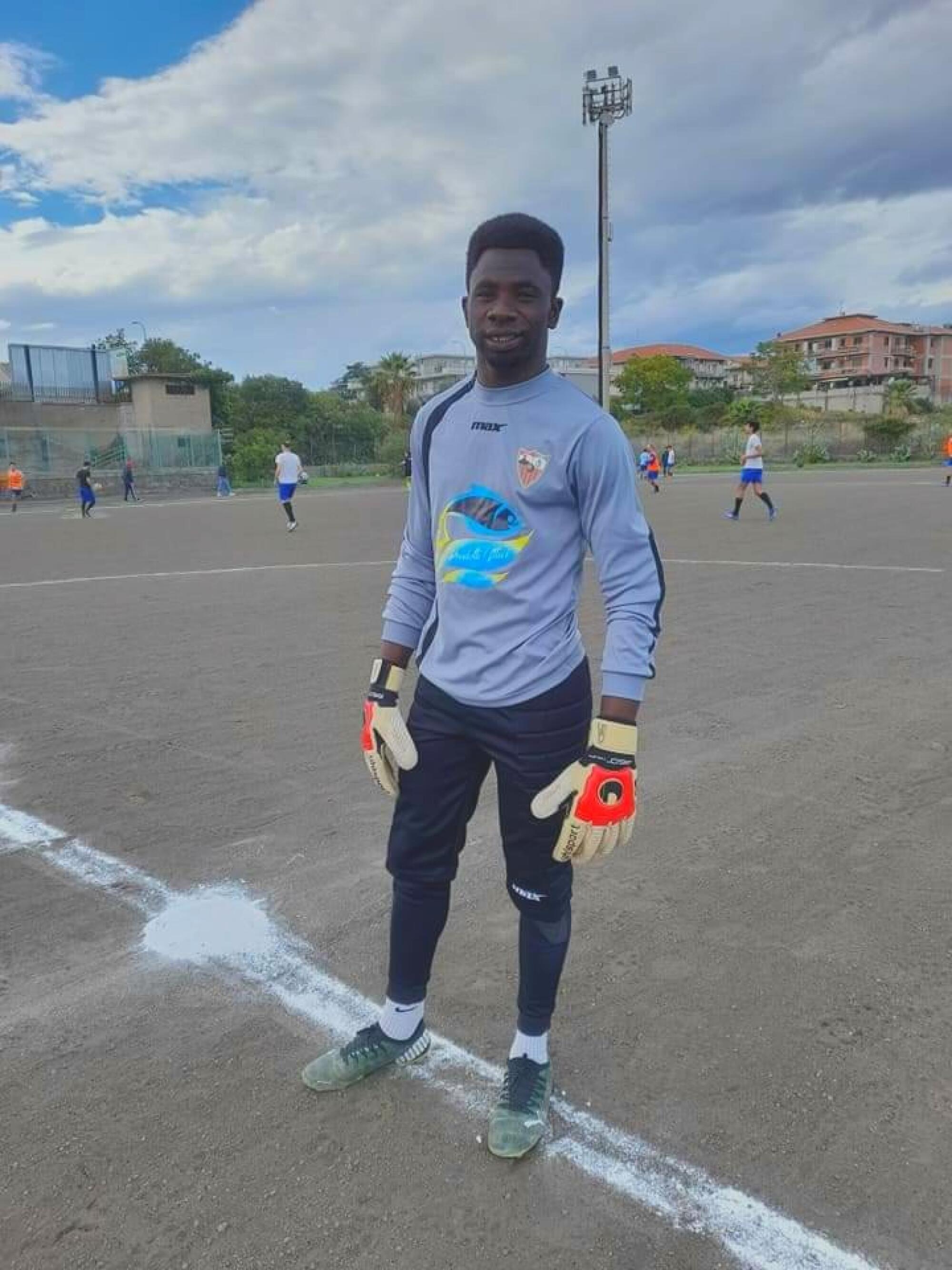
“They say, ‘OK, you will die here,’” Camara recalled, speaking in English at a Roman Catholic shelter in the Sicilian city of Catania, where the municipal cemetery has a monument to more than 200 unidentified migrants buried there after perishing at sea. “They put a gun to your head. … I saw them beating some people mercilessly. ... If you kill somebody in front of me, the first time, I will be terrified. The next day, if you kill someone in front of me, I will terrified again — but not the same as the first time. As time goes on, it becomes normal.”
He worked for a Libyan family as a sheep herder and befriended them, learning basic Arabic. These “good people” helped him escape. He scraped enough dinars together for the boat passage.
“Either I go or I die,” he calculated.
Camara arrived in Italy more than a year after he had left home. He was 17 and traumatized. He couldn’t sleep for three months. He shunned company.
“I thought I was crazy.”
Counselors in Sicily helped him recover. Today, he speaks fluent Italian, has legal residency and is completing his high school equivalency. In 2018, as part of a Catholic youth group that met Pope Francis, he took a selfie with the pontiff.
::
Sankoung, the aid worker in Sicily, is a soft-spoken young man who passed through a number of Italian shelters and foster homes as a child and now resides in a top-floor studio flat across the street from the soccer stadium in the Sicilian city of Siracusa.
He says he left Senegal in 2011 at age 13, an orphan. His parents, he said, were killed in his native southern region of Casamance, site of one of Africa’s most enduring, if least known, conflicts. He decamped alone in search of an older brother, his only sibling. He followed his brother’s trail toward Libya, once a stable destination under the dictatorship of Moammar Kadafi, who had declared himself Africa’s “King of Kings” and welcomed migrants from the south.
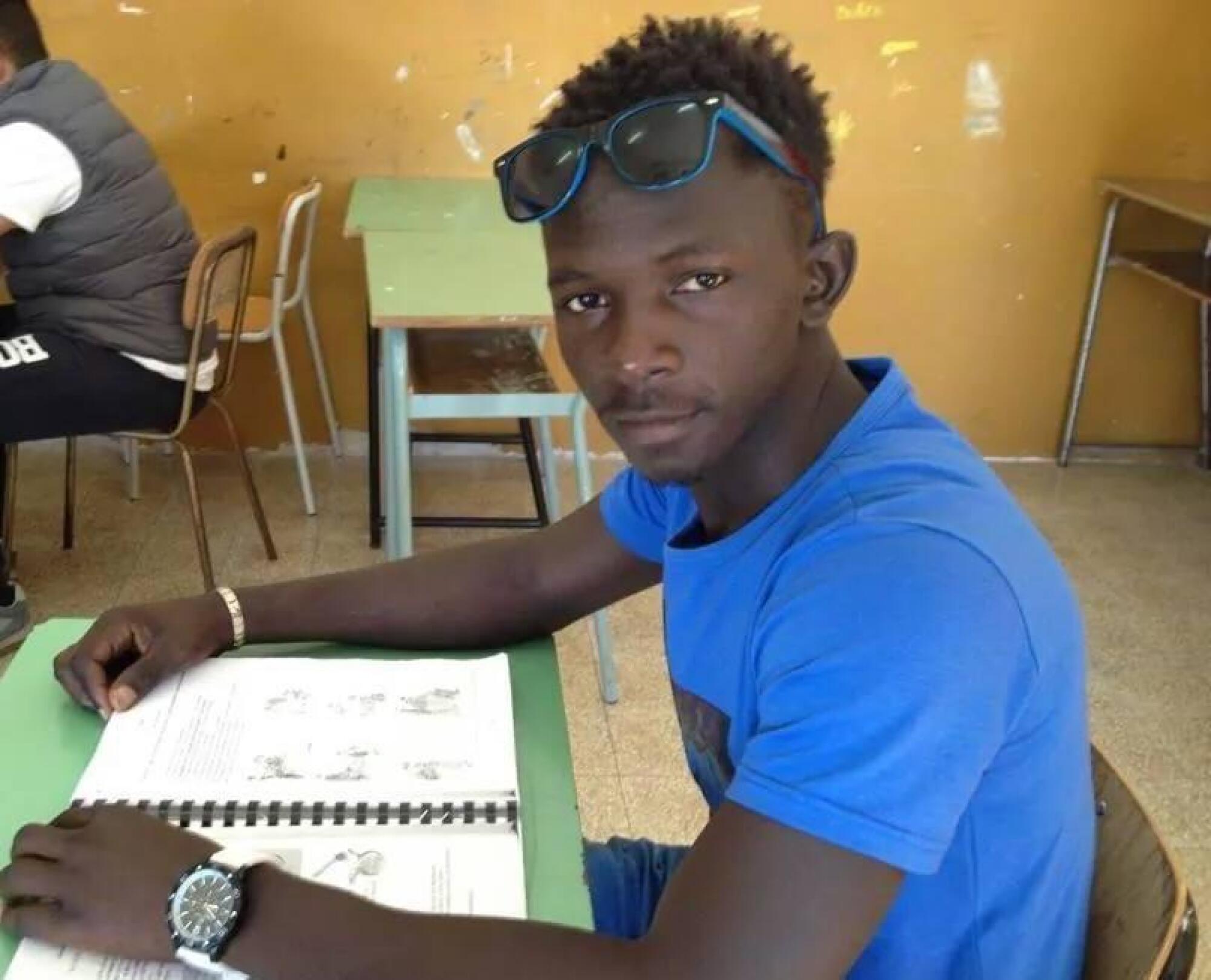
En route to Libya, Sankoung earned his keep cleaning buses in Mali but he was waylaid in Niger and forced to work in adobe construction. He finally made it to Libya in the chaotic aftermath of the insurrection against Kadafi. Sankoung joined the many Africans hastening for boats to Europe.
He boarded a rubber dinghy outside Tripoli that heaved with 114 people. Smugglers were beating passengers and cramming them into the vessel, as waves crashed at the shore, he recalled. In the chaos of the predawn darkness, Sankoung said, one young African man fell into the sea and drowned.
“I don’t know if we are going to make it,” Sankoung recalled thinking.
On the third day at sea, he said, the motor failed. The boat was adrift. Some around him fell ill from drinking seawater.
“We were in the hands of the wind,” he said.
After a day and night, a Spanish tanker stopped and took the migrants aboard. The ship docked here at Augusta — the same port where, nine years later, Sankoung would witness the arrival of the latest batch of rescued migrants, many, like him years back, teenagers with no idea of what would come.
At the pier in Augusta last month, a steady stream of young men exited the Sea-Watch 4 rescue ship, which had taken aboard almost 500 people from international waters off the Libyan coast. First off was an African man with twin 1-year-old sons.
Next were the 141 unaccompanied minors met by Red Cross workers and Italian officials in the gusty Sicilian evening. Many of the youths were barefoot. Mylar space blankets draped across their shoulders glistened a surreal golden hue as the vessel’s blinding strobe lights illuminated the post-dusk spectacle.
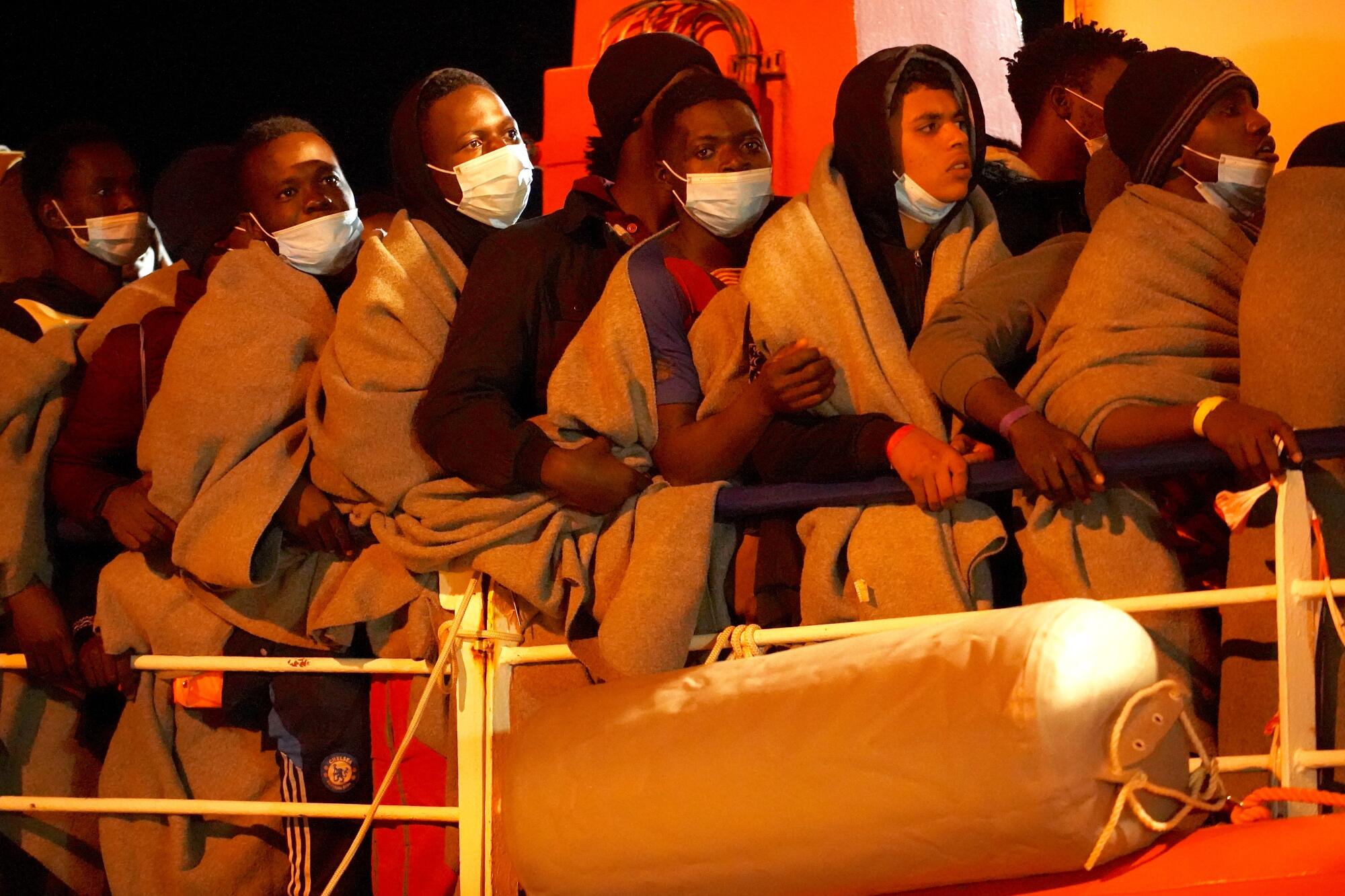
“I saw myself,” said Sankoung, standing on the quay.
Since his arrival, Sankoung has won Italian residency, learned the language and is studying biotechnology. He works at a residence for some 70 migrants, guiding them through the bureaucratic labyrinth. He never learned the fate of his brother.
“I have heard this phrase, that we are ‘the invisible,’” says Sankoung, speaking Italian. “Some people have been here for 30 years and [Italians] still treat them like they arrived yesterday. ... There is some badness here, yes, but in the end you have to understand that that, too, is part of humanity. And you have to avoid becoming a bad person yourself.”
All on board the Sea-Watch 4 had indeed made it to Europe, that long-imagined land with no famine or slave traders. But the continent held its own peril — a pivot between promise and adversity as daunting in some ways as setting off in an inflatable dinghy into the immensity of the Mediterranean.

(This is the ninth in a series of occasional stories about the challenges young people face in an increasingly perilous world. Reporting was supported by a grant from the Pulitzer Center.)
Times staff writers McDonnell reported from Augusta, Italy, and Necoclí, Colombia, and Bulos from Beirut. Special correspondents Liliana Nieto del Río in Necoclí and Augusta, Alessandro Puglia in Augusta, Juan Carlos Zapata in Necoclí and Cecilia Sánchez in Mexico City contributed to this report.
More to Read
Sign up for Essential California
The most important California stories and recommendations in your inbox every morning.
You may occasionally receive promotional content from the Los Angeles Times.
